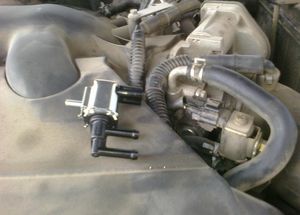
P2024 EVAP Fuel Vapor Temperature Sensor Circuit
Content
- P2024 EVAP Fuel Vapor Temperature Sensor Circuit
- OBD-II DTC Datasheet
- What does this mean?
- What is the severity of this DTC?
- What are some of the symptoms of the code?
- What are some of the common causes for the code?
- How to troubleshoot and fix the P2024 code?
- Related DTC discussions
- Need more help with the P2024 code?
P2024 EVAP Fuel Vapor Temperature Sensor Circuit
OBD-II DTC Datasheet
Evaporative emission (EVAP) fuel vapor temperature sensor circuit
What does this mean?
This is a generic powertrain diagnostic trouble code (DTC) and is commonly applied to OBD-II vehicles. This may include but is not limited to Mercedes Benz, VW, Audi, Subaru, Chevy, Dodge, BMW, Suzuki, Hyundai, Sprinter, etc. According to some reports, this code is more common on Mercedes-Benz vehicles.
Although general, the exact repair steps may vary depending on the model year, make, model, and transmission configuration.
Evaporative emission (EVAP) systems have been introduced into automobiles for several reasons. Some of these include, but are not limited to: reduced exhaust emissions, slightly improved fuel efficiency, and fuel vapor content that would otherwise be wasted. Not to mention the constant recycling of unused / unburned fuel, quite efficiently, isn't it?
That being said, the EVAP system requires a variety of sensors, switches and valves to maintain the desired emissions. The ECM (Engine Control Module) actively monitors and adjusts them according to the needs of the system. As the name suggests, the fuel vapor temperature sensor is used by the ECM to monitor the temperature of unburned vapor that would otherwise be released into the atmosphere.
It is important to note that the EVAP system uses primarily plastic components to deliver unburned fuel vapors to the engine for combustion. You can imagine the problems that can arise when you expose plastic to elements 24/7. These plastic parts, especially in particularly harsh winter conditions, tend to crack / split / break / clog. Food for thought.
The check engine light is activated with P2024 and associated codes P2025, P2026, P2027 and P2028 when the ECM detects that one or more electrical values are missing and / or out of a certain range in the EVAP sensor or one of the involved circuits. Whether it will be mechanical or electrical is difficult to say, but keep in mind that the overall health of the system involved, in this case the EVAP system, is and should always be a priority.
Code P2024 is set when the ECM monitors a general malfunction in the EVAP fuel vapor temperature sensor circuit.
What is the severity of this DTC?
As with most EVAP faults, I'd say this is a low level of severity. The whole system was mainly designed to reduce emissions into the atmosphere. It's obviously doing a lot more in the meantime, but whatever it says, really the only thing negatively impacting this bug is the atmosphere. At this point, I can't think of any problem with the EVAP system that could be detrimental to the overall safety of the car. This does NOT mean that you can continue driving day after day without resolving the problem. One problem always leads to another if left unresolved for too long.
What are some of the symptoms of the code?
Symptoms of a P2024 trouble code may include:
- Failed state / provincial pollutant emission test
- CEL (check engine light) on
- Slight reduction in fuel efficiency
- Fuel smell
- Possible symptoms of abnormal refueling (prolonged refueling, inability to fully pull the trigger of the fuel pump, etc.)
What are some of the common causes for the code?
Reasons for this P2024 fuel trim code may include:
- Defective EVAP fuel vapor temperature sensor (fuel vapor recovery)
- Obstruction / leak in the system causing the sensor to operate out of range (mainly P2025)
- Breakage or damage to the EVAP fuel vapor temperature sensor wiring harness
- Shorting the wire to power
- Excessive resistance in the circuit
- ECM (Engine Control Module) problem
- Pin / connector problem. (corrosion, melting, broken tongue, etc.)
How to troubleshoot and fix the P2024 code?
As mentioned above, the overall health of the EVAP (Evaporative Emissions) system is of great importance. Make sure the components involved are not clogged and there are no visible cracks in the plastic pipes. It would be nice to find a place where the EVAP system gets fresh ambient air, which is introduced into the system to regulate the pressure difference. In some cases, most of the parts used in this system will be located under the vehicle. I would recommend using wheeled ramps over a hydraulic jack and stands because of their convenience and, most importantly, the safety benefits.
NOTE: Be careful when disconnecting / handling EVAP tubing and hoses. They can often look healthy until you try to disconnect them and the clamp or the entire pipe breaks and now you need to replace / repair something to continue diagnosing. Be extremely careful here.
Check the sensor. In my experience, the ECM uses voltage readings from the EVAP sensor to monitor the temperature. Most likely, there is a special pinout test that can be performed to test the functionality of the sensor.
Related DTC discussions
- There are currently no related topics in our forums. Post a new topic on the forum now.
Need more help with the P2024 code?
If you still need help with DTC P2024, post a question in the comments below this article.
NOTE. This information is provided for informational purposes only. It is not intended to be used as a repair recommendation and we are not responsible for any action you take on any vehicle. All information on this site is protected by copyright.

